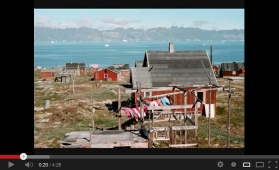Ever since the missionary Hans Egede arrived in Greenland, the country has, to various degrees, been under Danish influence. The Danish state as colonizer effectuated a strategy by which Greenland was kept relatively isolated, a strategy that was justified through a discourse in which Greenlanders, as ‘indigenous people’, needed to be protected from the consequences of a sudden transformation to the ‘modern’ way of life in the ‘civilized’ world. This strategy was interrupted as World War II broke out and Germany occupied Denmark in 1940. Because of the occupation, Greenland needed new diplomatic connections in order to import the foreign goods needed to maintain status quo. Furthermore, both Allied and German air forces had strategic interests in Greenlandic territory, and the US therefore considered it necessary to protect Greenlandic territory. The Danish envoy Hendrik Kauffmann therefore gave the US permission to build military bases in Greenland in 1941, in return for supplying the population with foreign goods. This resulted in a considerable expansion of the assortment of goods available in Greenland (DIIS 2007: 14-5, 21-31), and as a result of the presence of American military bases in Greenland, American guitar-based music became available in large parts of the country. It was also possible during the war to listen to radio stations from neighboring countries like Iceland and Canada (Lynge 1981: 31; Interview with P. O. Petersen, 19 December 2012). The national Greenlandic broadcasting service Grønlands Radio, later Kalaallit Nunaata Radioa (KNR), furthermore initiated official broadcasting during the war in 1942, even though some local broadcasting had been taking place as far back as 1926 (Lynge 1981: 31-2).
American popular music quickly became popular in Greenland, and in the 1950s, the first locally-produced popular music emerged. This music consisted, to a large extent, of versions of American country and western music with Greenlandic lyrics, and as a style this music has been given the name ‘vaigat music’, since it was mainly practiced in the mining town of Qullissat by the Vaigat Straight. But the genre gained national recognition and fame through the Greenlandic national broadcasting service (Lynge 1981: 35-8; Johansen 1991: 50; Johansen 2001: 171-3).
The emergence and popularity of vaigat music illustrate the double character of radio. Radio has played a significant role in unifying and building new nation-states, and has been used to distribute and establish new versions of national culture (Stokes 1994: 11-2; Baily 1994: 51, 58). This is the case for Greenland, where the national broadcasting service has been seen as one of the strongest unifying factors in post-war Greenland (Lynge 1981: 38), but radio in Greenland has also been a way of gaining access to culture from elsewhere, in a time when this access was limited. Radio is thus, as cultural studies researcher Jody Berland has noted, an ideal instrument for collective self-construction (Berland 2009: 207), but it is also an instrument for gaining a cosmopolitan outlook (cf. Cohen 1999: 244).
Fig. 4: Vaigat music by Vajgat Orkesteret ”Nuna Hawaii” (’The land Hawaii’) (1988).
Radio and imported LPs inspired the first rock music, which emerged in Greenland in the 1960s through genres like beat, and rock and roll. The most famous band from the first wave of Greenlandic rock was The Eskimos, a band that was active in the mid-1960s. The band recorded two EPs in Nuuk in 1965. These recordings made use of repertoire from internationally recognized bands and artists like The Ventures and The Beatles (from when they were Tony Sheridan and the Beat Brothers). But a rendition of the track “Hello Mr. Twist” with Danish lyrics (called “Mr. Twist” on the EP), that had been released by the Danish iconic artist Otto Brandenburg in 1962, also points towards influence from the Danish rock and roll scene even though “Hallo Mr. Twist” had already been released by Billy Sanders in a German and English version in 1961 (cf. fig. 5).
The Eskimos almost exclusively performed cover music (music that was primarily known as played by other bands and artists) and except for the lead singer Barselaj Danielsen’s curious English accent, it is not immediately possible to locate a Greenlandic place in the rock and roll hits performed by The Eskimos. This impression does however change if we look at another type of music recorded by the band. One of these tracks is named “A-E-Sakissak”. Sakissak or saqisaaq, according to recent orthography, is a type of polka (also known as rheinlænder) from the kalattuut repertoire, and the Eskimos performed the music using rock and roll instruments. Thus while performing rock and roll hits from an international repertoire, the Eskimos also performed dance music that had a history stretching back centuries in western Greenland. It was this mix of international rock and roll and kalattuut that made the Eskimos the most popular band of their time. They had the knack of matching audience preferences to musical styles (Interview with P. O. Petersen, 19 December 2012). This example illustrates Connell and Gibson’s argument that new cultural alliances do not happen on a ‘blank slate’. The particular set of circumstances, traditions and social relations of older generations of cultural producers are inherited in some form (Connell and Gibson 2003: 14).
Fig. 5: ”Mr. Twist” performed by The Eskimos (1965).


